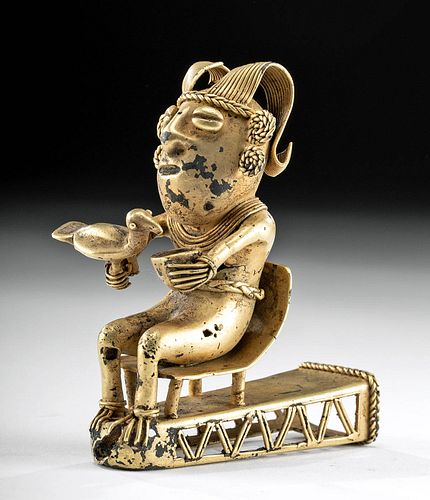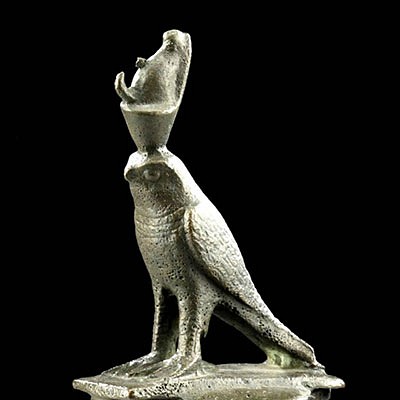Sinu Tumbaga Seated Shaman Finial w/ Bird
Lot 73
About Seller
Artemis Fine Arts
686 S Taylor Ave, Ste 106
Louisville, CO 80027
United States
Selling antiquities, ancient and ethnographic art online since 1993, Artemis Gallery specializes in Classical Antiquities (Egyptian, Greek, Roman, Near Eastern), Asian, Pre-Columbian, African / Tribal / Oceanographic art. Our extensive inventory includes pottery, stone, metal, wood, glass and textil...Read more
Estimate:
$3,500 - $5,000
Absentee vs Live bid
Two ways to bid:
- Leave a max absentee bid and the platform will bid on your behalf up to your maximum bid during the live auction.
- Bid live during the auction and your bids will be submitted real-time to the auctioneer.
Bid Increments
| Price | Bid Increment |
|---|---|
| $0 | $25 |
| $300 | $50 |
| $1,000 | $100 |
| $2,000 | $250 |
| $5,000 | $500 |
| $10,000 | $1,000 |
| $20,000 | $2,500 |
| $50,000 | $5,000 |
| $100,000 | $10,000 |
| $200,000 | $20,000 |
About Auction
By Artemis Fine Arts
Feb 11, 2021
Set Reminder
2021-02-11 12:00:00
2021-02-11 12:00:00
America/New_York
Bidsquare
Bidsquare : Animals in Art | Antiquity to Present Day
https://www.bidsquare.com/auctions/artemis-gallery/animals-in-art-antiquity-to-present-day-6391
From beloved pets to dedicated servants and vital livestock to symbolic imagery from many religions, animals frequently show up in the art of all cultures, ancient times to the present. Artemis Fine Arts info@artemisgallery.com
From beloved pets to dedicated servants and vital livestock to symbolic imagery from many religions, animals frequently show up in the art of all cultures, ancient times to the present. Artemis Fine Arts info@artemisgallery.com
- Lot Description
Pre-Columbian, Colombia, Sinu Valley, Sinu culture, ca. 1000 to 1500 CE. An interesting finial formed from tumbaga which contains 71% copper, 25% gold, and 3% silver. Atop the socketing shaft is a highly stylized anthropomorphic figure that sits in a four-legged chair and holds a petite olla in one hand while grasping the legs of a plump avian creature in the other hand. A braided cord adorns the waistline while a layered pectoral collar festoons the neck. The narrow visage is flanked with two pairs of braided ear ornaments, and two lengthy projections sweep back behind the head. An openwork rectangular plinth has zigzagging bars on either side of the open bottom and in front of a braided socketing rim. Size: 2.6" L x 1.4" W x 3" H (6.6 cm x 3.6 cm x 7.6 cm); quality of tumbaga: 71% copper, 25% gold, 3% silver; total weight: 55 grams
An item like this one would have perhaps been used for ritual ceremonies in which shamans and possibly rulers consumed powerful hallucinogens to induce a religious transformation into animals or magical beasts. Birds were a popular theme in ancient Mesoamerican art as they were thought to be messengers of the gods who were able to traverse through all realms of existence as well as the afterlife. An object like this example aided in the months to years long process through which a shaman completed the animalistic transformation. To learn more about objects like this one, please see the British Museum catalog/exhibit entitled "Beyond El Dorado: Power and Gold in Ancient Colombia."
Provenance: private Hawaii, USA collection, acquired October 6, 2019 at auction at Showplace; ex-private New York, New York, USA collection; ex-private Park Avenue collection, New York, New York, USA
All items legal to buy/sell under U.S. Statute covering cultural patrimony Code 2600, CHAPTER 14, and are guaranteed to be as described or your money back.
A Certificate of Authenticity will accompany all winning bids.
We ship worldwide and handle all shipping in-house for your convenience.
#156160Small losses to areas of headdress. Abrasions and several perforations to figure and socketing base, with slight bending and a few stable hairline fissures to headdress elements, arms, and base, and light encrustations. Light earthen deposits and nice patina throughout.Condition
- Shipping Info
-
All shipping is handled in-house for your convenience. Your invoice from Artemis Gallery will include shipping calculation instructions. If in doubt, please inquire BEFORE bidding for estimated shipping costs for individual items.
-
- Buyer's Premium



 EUR
EUR CAD
CAD AUD
AUD GBP
GBP MXN
MXN HKD
HKD CNY
CNY MYR
MYR SEK
SEK SGD
SGD CHF
CHF THB
THB
















